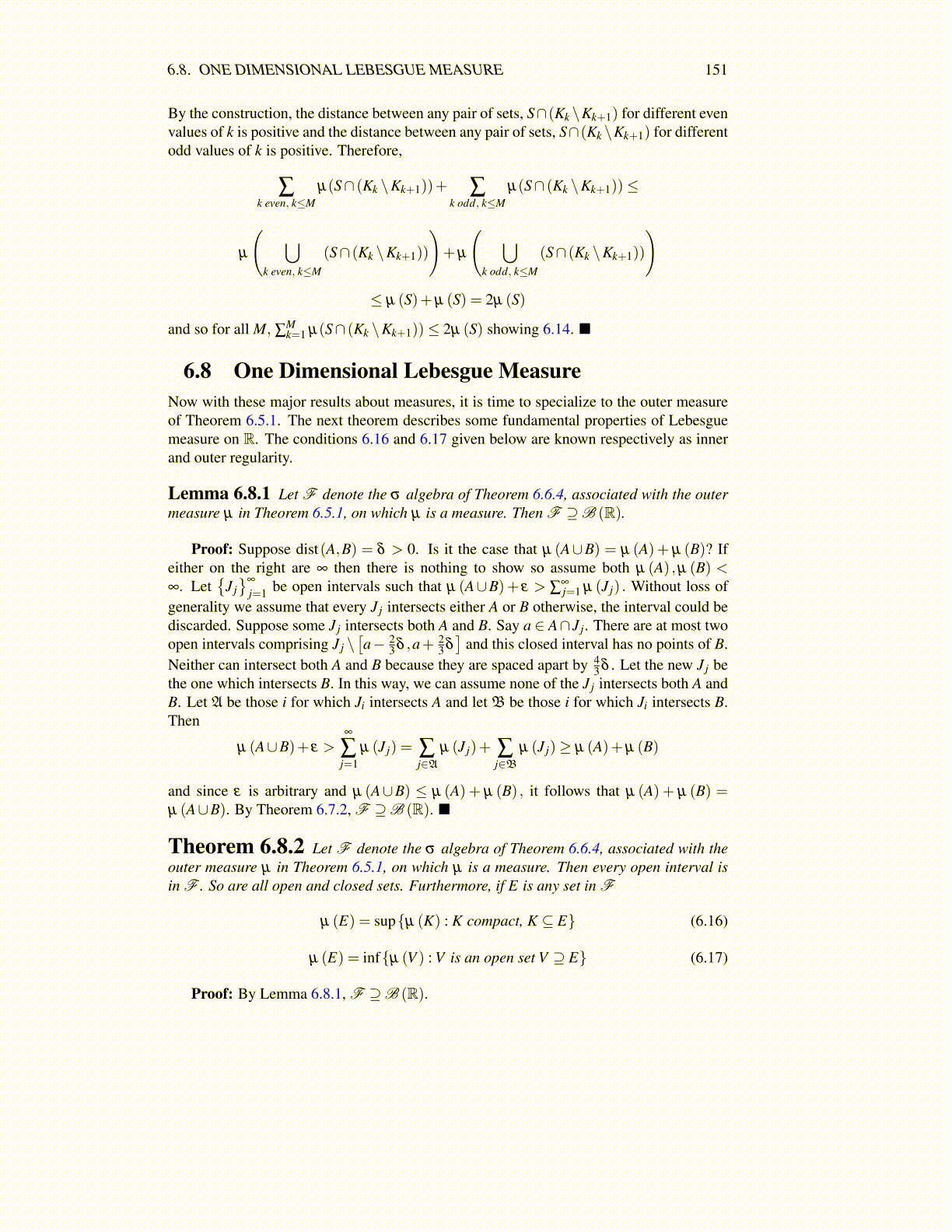
6.8. ONE DIMENSIONAL LEBESGUE MEASURE 151
By the construction, the distance between any pair of sets, S∩(Kk \Kk+1) for different evenvalues of k is positive and the distance between any pair of sets, S∩(Kk \Kk+1) for differentodd values of k is positive. Therefore,
∑k even, k≤M
µ(S∩ (Kk \Kk+1))+ ∑k odd, k≤M
µ(S∩ (Kk \Kk+1))≤
µ
( ⋃k even, k≤M
(S∩ (Kk \Kk+1))
)+µ
( ⋃k odd, k≤M
(S∩ (Kk \Kk+1))
)
≤ µ (S)+µ (S) = 2µ (S)
and so for all M, ∑Mk=1 µ(S∩ (Kk \Kk+1))≤ 2µ (S) showing 6.14. ■
6.8 One Dimensional Lebesgue MeasureNow with these major results about measures, it is time to specialize to the outer measureof Theorem 6.5.1. The next theorem describes some fundamental properties of Lebesguemeasure on R. The conditions 6.16 and 6.17 given below are known respectively as innerand outer regularity.
Lemma 6.8.1 Let F denote the σ algebra of Theorem 6.6.4, associated with the outermeasure µ in Theorem 6.5.1, on which µ is a measure. Then F ⊇B (R).
Proof: Suppose dist(A,B) = δ > 0. Is it the case that µ (A∪B) = µ (A)+ µ (B)? Ifeither on the right are ∞ then there is nothing to show so assume both µ (A) ,µ (B) <∞. Let
{J j}∞
j=1 be open intervals such that µ (A∪B)+ ε > ∑∞j=1 µ (J j) . Without loss of
generality we assume that every J j intersects either A or B otherwise, the interval could bediscarded. Suppose some J j intersects both A and B. Say a ∈ A∩ J j. There are at most twoopen intervals comprising J j \
[a− 2
3 δ ,a+ 23 δ]
and this closed interval has no points of B.Neither can intersect both A and B because they are spaced apart by 4
3 δ . Let the new J j bethe one which intersects B. In this way, we can assume none of the J j intersects both A andB. Let A be those i for which Ji intersects A and let B be those i for which Ji intersects B.Then
µ (A∪B)+ ε >∞
∑j=1
µ (J j) = ∑j∈A
µ (J j)+ ∑j∈B
µ (J j)≥ µ (A)+µ (B)
and since ε is arbitrary and µ (A∪B) ≤ µ (A) + µ (B) , it follows that µ (A) + µ (B) =µ (A∪B). By Theorem 6.7.2, F ⊇B (R). ■
Theorem 6.8.2 Let F denote the σ algebra of Theorem 6.6.4, associated with theouter measure µ in Theorem 6.5.1, on which µ is a measure. Then every open interval isin F . So are all open and closed sets. Furthermore, if E is any set in F
µ (E) = sup{µ (K) : K compact, K ⊆ E} (6.16)
µ (E) = inf{µ (V ) : V is an open set V ⊇ E} (6.17)
Proof: By Lemma 6.8.1, F ⊇B (R).